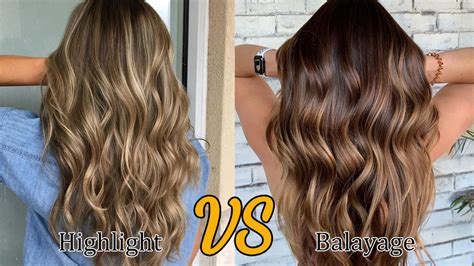When considering a hair makeover, deciding between balayage and highlights can be a crucial choice, especially for those with dark hair. These two hair coloring techniques offer distinct results and can cater to different preferences and needs. Here’s a comprehensive guide to help you understand the key differences between balayage and highlights on dark hair.

What is Balayage?
Balayage is a freehand hair coloring technique that involves painting color onto the hair’s surface. The term “balayage” comes from the French word meaning “to sweep,” and it mimics the natural sun-kissed effect of hair that has been exposed to the sun. Balayage creates soft, gradual transitions between colors, resulting in a natural-looking, lived-in look.
What are Highlights?
Highlights are a more traditional hair coloring technique that involves using foils to isolate sections of hair and apply color. The result is more defined strands of lighter color that contrast against the darker base color. Highlights can be placed throughout the hair to create a variety of looks, from subtle to bold.
5 Key Differences Between Balayage and Highlights
- Technique: Balayage is painted on, while highlights are applied using foils.
- Results: Balayage creates a natural, sun-kissed effect with gradual transitions, while highlights create more defined, contrasting strands.
- Maintenance: Balayage typically requires less maintenance than highlights, as the root growth is less noticeable.
- Suitability for Dark Hair: Balayage is particularly well-suited for dark hair, as it enhances the depth and dimension of the base color.
- Cost: Balayage is generally more expensive than highlights, due to the time and skill required to apply it.
Pros and Cons of Balayage on Dark Hair
Pros:
- Creates a natural, sun-kissed effect
- Enhances depth and dimension of dark hair
- Requires less maintenance than highlights
- Can help to disguise gray hair
Cons:
- Can be more time-consuming and expensive than highlights
- May not be suitable for all hair types
- Requires a skilled colorist to achieve the desired results
Pros and Cons of Highlights on Dark Hair
Pros:
- Creates a more defined, high-contrast look
- Can be used to create a variety of styles
- Can help to brighten the face and draw attention to features
- Can be less expensive than balayage
Cons:
- Requires more maintenance than balayage
- Root growth can be more noticeable
- May not be suitable for all hair types
- Requires a skilled colorist to avoid brassiness
Choosing the Right Technique for You
The best way to choose between balayage and highlights is to consider your personal preferences, hair type, and desired results. Here are some guidelines:
- If you want a natural, sun-kissed look that requires less maintenance: Balayage is a good choice.
- If you prefer a more defined, high-contrast look with more versatility: Highlights are a good choice.
- If you have dark hair and want to enhance its depth and dimension: Balayage is the better option.
- If you have a tight budget: Highlights are generally more affordable than balayage.
Tips for Getting the Best Results
- Consult with a skilled colorist who specializes in balayage or highlights on dark hair.
- Discuss your desired results and ask for their recommendations.
- Consider your hair type and condition before choosing a technique.
- Use professional-grade hair care products to maintain the color and health of your hair.
- Get regular trims to remove split ends and keep your hair looking its best.
Conclusion
Balayage and highlights are both versatile hair coloring techniques that can create beautiful results on dark hair. By understanding the key differences between these techniques, you can make an informed decision about which one is right for you. With proper care and maintenance, you can enjoy your new hair color for months to come.
